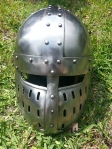 There are many types of period helmets/head protection that one can invest in for Medieval/Renaissance/Historical European Martial Arts. In our martial arts organization you still typically see steel armour helmets. Soon enough there will be more and more heavy fencing H.E.M.A. masks involved in our training sessions, but we like the weight and sensory limitations that a period helm places a fighter under to give us a feel for what out forefathers in these martial arts experienced. The helmet we will be looking at is the get Dressed for Battle, Crusader Spangen Helmet.
There are many types of period helmets/head protection that one can invest in for Medieval/Renaissance/Historical European Martial Arts. In our martial arts organization you still typically see steel armour helmets. Soon enough there will be more and more heavy fencing H.E.M.A. masks involved in our training sessions, but we like the weight and sensory limitations that a period helm places a fighter under to give us a feel for what out forefathers in these martial arts experienced. The helmet we will be looking at is the get Dressed for Battle, Crusader Spangen Helmet.
I’ve recently decided to try out this helmet as a replacement for my great helm that I have been wearing for around eight years, and I’ve decided to write a review on the helmet after having some freestyle matches utilizing it. Firstly, the helmet is comfortable to wear and mounts very well on the head. There is room for an arming cap and coif, and you will need that for this helmet. The helmet have wonderful visibility and the breathability inside of this helmet is also great. That said, the oculars on the helmet’s face mask (it is not a hinged visor helm) are larger enough that I highly recommend wearing protective eye hardware inside of the helmet. I use hard plastic eye protection made for doing yard/garden work (mowing and edging). It is not a guarantee against injury, but an added element to help keep the wearer safer in sparring with rebated swords, etc… Continue reading “Review: Crusader Spangen Helm by Get Dressed for Battle”

